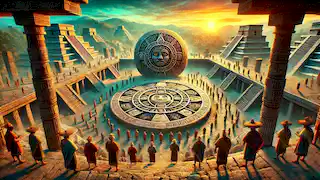Introduction
Long ago, the mighty Aztec Empire thrived in the Valley of Mexico. Its capital, Tenochtitlan, shimmered like a jewel in the midst of a sprawling lake. Towering temples, bustling markets, and awe-inspiring rituals all showcased the grandeur of the Aztecs. However, one artifact stood above the rest, steeped in both myth and history: the Sun Stone, also known as *Tonatiuh Itztlacoliuhqui*.
The Sun Stone was not merely a relic. It embodied the very essence of the Aztec cosmos—their gods, their destiny, and the cycles of time that bound their lives to the universe. Legends say that the Sun Stone was more than a calendar; it was a divine prophecy carved into stone. And within its intricate carvings lay the key to understanding the fate of the Aztec people, their rise, and their ultimate fall.
This story delves deep into the mythos surrounding the Sun Stone, intertwining fact and fable, revealing a tale of divine power, betrayal, and sacrifice that shaped the Aztec civilization.
The Creation of the Sun Stone
In the heart of Tenochtitlan, the grand temple of the sun god, *Tonatiuh*, loomed above the city. The high priests, dressed in feathered cloaks and adorned with gold, gathered at the temple’s summit. The people below waited in reverence, for today was a momentous occasion—the consecration of the Sun Stone.
The Aztecs believed that the world had been created and destroyed four times before, each ending in cataclysmic disasters. The current era, the Fifth Sun, was a fragile balance, requiring constant offerings to keep the sun god pleased. The Sun Stone was to be the embodiment of this era’s balance, marking the cycles of time and commemorating the sacrifices made to preserve the world.
The stone itself was a massive disk, carved from volcanic rock. It displayed intricate symbols and glyphs that detailed the history of the cosmos, the gods, and the passage of time. At its center, the fierce face of *Tonatiuh* stared out with an open mouth, demanding the sacrifice of hearts to keep the sun moving across the sky. Surrounding him were the four previous suns, each representing an age destroyed by elements of wind, jaguars, fire, and floods.
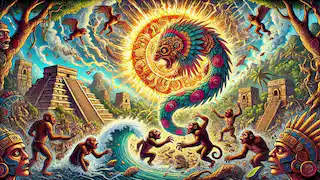
Legend has it that the stone was crafted by a master artisan named *Cuauhtlixochitl*. Blessed with divine inspiration, he received visions from *Tonatiuh* himself, guiding his hands in the creation of the masterpiece. Cuauhtlixochitl was no ordinary artist; he had been chosen since birth by the gods. His parents had seen an eagle fly above their home the night he was born, a sign that he would serve the gods in ways no one else could.
The day of the stone’s completion had arrived. The priests raised their hands to the heavens, chanting hymns of praise to *Tonatiuh* as the people below bowed their heads. Cuauhtlixochitl stood near the base of the temple, his hands trembling with anticipation. He had poured his heart and soul into the Sun Stone, believing it to be the most sacred work of his life. Yet, in the depths of his heart, he harbored a secret—a secret that would soon bring doom upon Tenochtitlan.
The Omen
The ceremony began at dawn. The first rays of sunlight pierced the horizon, casting an ethereal glow over the city. The stone was lifted to its place of honor atop the temple, where it would stand as a monument to the gods and a warning to future generations. The high priest, a man named *Tlalocelotl*, raised his obsidian blade, ready to offer the first sacrifice to consecrate the stone.
Suddenly, a chill wind swept through the air, and the sky darkened, as if night had fallen too soon. The people below murmured in confusion, while the priests exchanged worried glances. A sense of foreboding settled over the crowd. Some claimed to see figures moving within the clouds, dark silhouettes watching from the heavens.
Cuauhtlixochitl felt a surge of panic rise in his chest. This was no ordinary storm. He had seen this in his dreams—a warning from the gods. He pushed his way through the crowd, desperate to reach the temple before it was too late. But before he could reach the summit, a great crack of thunder echoed across the sky.
The priests froze as a massive lightning bolt struck the Sun Stone, splitting the air with an ear-splitting roar. The stone shook violently on its pedestal, but it did not break. Instead, a faint glow began to radiate from its surface, as if the gods themselves were awakening within it.
Tlalocelotl, still gripping the blade, hesitated. He gazed at the stone, and his eyes widened in terror. "The gods are angry," he whispered. "We have disturbed the balance."
Cuauhtlixochitl reached the top of the temple just as the stone's glow intensified. He had seen this before—in his vision. The gods had shown him the future, and he knew what was about to happen. But no one would listen. The stone was cursed.
The Curse of the Stone
Many believed the Sun Stone to be an artifact of great power, but few knew its darker secrets. Cuauhtlixochitl had been gifted with the ability to carve the stone, but the gods had warned him of its true purpose. The stone was not just a calendar; it was a gateway to the underworld, a channel for the ancient forces of chaos.
When *Tonatiuh* had first revealed the stone to Cuauhtlixochitl in his dreams, he had also shown him a terrible vision—the destruction of the Fifth Sun. In his vision, the stone would awaken when the gods became displeased with the Aztecs' offerings. The stone would summon the forces of darkness, and the sun would cease to rise.
Despite the warnings, the priests had demanded the stone's completion. They believed their offerings were enough to appease the gods. But Cuauhtlixochitl knew the truth: the gods' wrath could not be held at bay forever.
As the storm raged over Tenochtitlan, the Sun Stone’s glow began to shift, casting strange shadows across the temple. Tlalocelotl, still frozen in fear, dropped his blade. The stone seemed to pulse, as if alive, and from its surface, ghostly figures began to emerge.
These figures were the souls of those sacrificed in the past, bound to the stone by blood. They swirled around the temple, their mournful wails echoing through the city. The people below screamed in terror, fleeing for their lives as the apparitions descended upon them.
Cuauhtlixochitl knew that there was only one way to stop the curse. He had to destroy the Sun Stone. But doing so would come at a great cost—his own life.
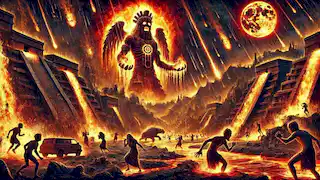
The Sacrifice
With the city in chaos, Cuauhtlixochitl climbed to the summit of the temple once more. The wind howled around him, and the spirits of the dead clawed at him as he approached the stone. He could feel their cold touch on his skin, their voices begging for release.
Tlalocelotl, now on his knees, wept as he looked up at Cuauhtlixochitl. "The gods have forsaken us," he cried. "What have we done?"
Cuauhtlixochitl placed his hands on the stone, feeling its cold surface beneath his fingers. He could feel the power surging within it, the dark forces waiting to be unleashed. He knew what he had to do. With a heavy heart, he raised the obsidian blade that Tlalocelotl had dropped, ready to make the ultimate sacrifice.
As he prepared to drive the blade into his chest, a voice echoed in his mind—*Tonatiuh’s* voice. "You were chosen for this, Cuauhtlixochitl. You are the key to balance. Only your blood can save the world."
Without hesitation, Cuauhtlixochitl plunged the blade into his heart. As his blood spilled onto the Sun Stone, the glow intensified, blinding those who were watching. The spirits screamed as they were sucked back into the stone, their souls finally released from their torment.
The storm began to dissipate, and the clouds parted, revealing the sun once more. The people of Tenochtitlan watched in awe as the sky cleared, and the Sun Stone returned to its normal state.
But Cuauhtlixochitl was gone. His body lay lifeless at the base of the stone, his sacrifice complete.
The Aftermath
The people of Tenochtitlan mourned the loss of Cuauhtlixochitl, the man who had saved them from the wrath of the gods. His name became legend, spoken of in reverence for generations to come.
The Sun Stone remained atop the temple, a reminder of the delicate balance between the gods and the people. Though the curse had been lifted, the Aztecs knew that their fate was always tied to the will of the gods. They continued their rituals and offerings, never forgetting the price that had been paid to keep the Fifth Sun alive.
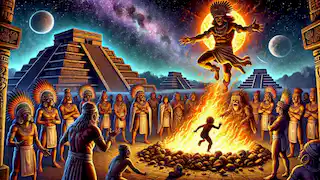
Over time, the Sun Stone became an object of great fascination. Scholars and priests studied its symbols, hoping to unlock its secrets. But no one could ever truly understand the power that lay within it
. Some said that the stone still held the spirits of the sacrificed, waiting for the day when they would be called upon again.
Years passed, and the Aztec Empire flourished. Yet, in the back of everyone’s minds, the legend of the Sun Stone lingered. They knew that the balance between the gods and the world was fragile. And as long as the Sun Stone remained, the threat of darkness would never be far away.
The Fall of Tenochtitlan
The prophecy of the Sun Stone was not one that could be easily forgotten. As the years went by, the Aztec Empire grew in power, but so too did the signs of the gods’ displeasure. Droughts, floods, and other natural disasters began to plague the empire, as if the stone’s curse had merely been delayed.
When the Spanish conquistadors arrived in 1519, led by Hernán Cortés, they saw the grandeur of the Aztec civilization and sought to conquer it for their own. But the Aztecs, under the leadership of Emperor Moctezuma, believed that these foreign invaders were the fulfillment of an ancient prophecy—the return of the god *Quetzalcoatl*.
In the chaos of the conquest, the Sun Stone was lost, buried beneath the rubble of Tenochtitlan as the city fell to the Spanish. The great empire crumbled, and with it, the legacy of the stone was nearly forgotten.
Epilogue: Rediscovery
Centuries later, in 1790, the Sun Stone was rediscovered beneath the streets of modern-day Mexico City. Workers digging near the Zócalo unearthed the massive stone, its carvings still intact after all those years.
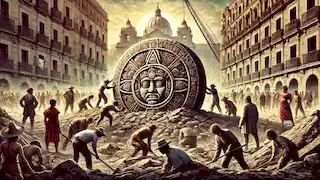
Today, the Sun Stone stands as a symbol of the Aztec civilization, a relic of a bygone era. But for those who know the legend, it is more than just a calendar. It is a reminder of the fragile balance between humanity and the gods, and the sacrifices that must be made to keep the world in harmony.
As visitors gaze upon the Sun Stone in the Museo Nacional de Antropología, they cannot help but wonder—what secrets still lie hidden within its ancient carvings? What power does it still hold? And could the curse of the Sun Stone one day return to haunt the world once more?
